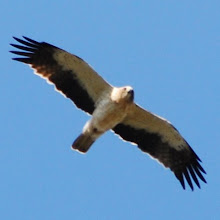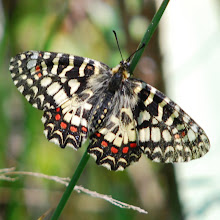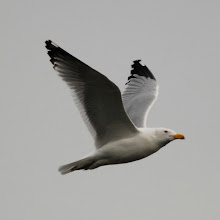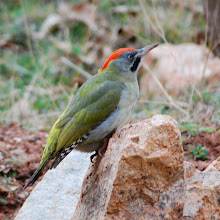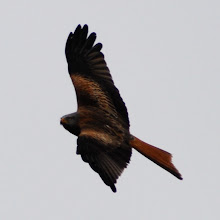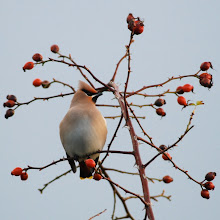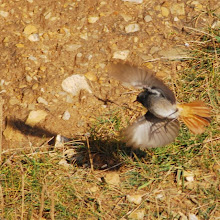Mark phoned me on Friday and told me I might want to go seawatching on Sunday. How glad am I that I took his advice!
This was one of the best seawatches I have had. The wind was North-Westerly, force 6-7 and there were regular, torrential downpours - apart from that it was lovely!!
Almost all of the birds we saw were going North, into the wind, as seems to be the norm here. The theory is, at least after a strong northerly blow, that birds are returning North, having been pushed South by the wind. However on days like today, the birds are heading North before the wind has died down. Perhaps they drift South on the sea overnight, then feel they have to re-orient themselves the next day, regardless of how horrible the weather is!
The obvious highlights are indicated in blue below, but saying that we had 3 diver species, 3 skua species, 2 shearwater species, 2 petrel species, 4 auk species (without puffin!) and 11 duck species illustrates just how good it was today!!
Red-throated Diver 5N 6S
Black-throated Diver 1N
Great Northern Diver 4N
Manx Shearwater 2N
Balearic Shearwater 1N
Fulmar 230 N
"blue" Fulmar 1N
Leach's Petrel 1N
Storm Petrel 1N
Gannet 70N
Eider 11N 14S
Common Scoter 254N 12S
Velvet Scoter 2N
Long-tailed Duck 4N
Gadwall 2N
Wigeon 9N
Teal 19N 1S
Pochard 4N
Goldeneye 4N 1S
Red-breasted Merganser 10N 6S
Shoveller 2N
Grey Plover 11N
Bar-tailed Godwit 9N
Purple Sandpiper 4N
Snipe 1N
Bonxie 12N 1S
Pomarine Skua 1N
Arctic Skua 1N
Little Gull 8N
argentatus Herring Gull 2N
Kittiwake 2700+N
Black Guillemot 1N
Little Auk 2N
Sunday 29 November 2009
Saturday 28 November 2009
More camera testing
This new dSLR has a video or "live view" mode. It really doesn't allow great results when hand-held, especially with the long lens on. However perhaps it might be useful for capturing fly-pasts during seawatching from a tripod. Here's a first attempt from the tripod - things can only get better!
Labels:
birds,
Black-headed Gull,
dSLR,
Seaham,
Sunderland,
test,
video
Sunday 22 November 2009
Testing a new camera!
After a recent trip to Spain with Oliva Rama Tours to look for Iberian Wolf (we saw 2 between us!) my camera was stolen from my checked in luggage!
It was a fantastic trip with Iberian Wolf, Wild Boar, 300+ Great Bustards, 3 Little Bustards, 5 Black-bellied Sandgrouse, 3 Black-shouldered Kites etc. etc. etc. but I have no photos to show here. My memory card was in the camera - so there's a lesson - take your card out of the camera and put it safe on the way home!
Anyway, I already have my replacement camera from the insurance and it's a Nikon D90 - a slightly more modern model. So I took it out for a test drive today.
Here are one or two photos from Herrington Country Park:
Black-headed Gull
"nordic" Jackdaw
"nordic" Jackdaw with Jackdaw behind
Moorhen
Saturday 5 September 2009
Found List
Seawatching has been a bit frustrating at Whitburn recently, at least in comparison with previous years. Seemingly permanent Westerlies finally started to have a hint of Northerly in them in the last three days.
Today looked like it had some promise early on - Kittiwakes seemed to be coming past with much more speed and purpose and large numbers of very distant Manx Shearwaters were bombing through.
Bird of the morning was a juvenile Sabines Gull - poor distant views as it was only picked up having almost passed us to the north. It was a landmark for me though seeing as it was a "find tick". Sabine's Gull is a species I have always wanted to find - ever since I started reading Heinzel, Fitter and Parslow 25 years ago!
So, my "found list" is the number of species I have found in the UK, for myself (or at east as part of a group having made a contribution to the finding) using punkbirder rules – and it is now at 263.
To be honest it is the only birding "list" I really care about - I get a thrill from discovering a bird for myself or discovering a bird with friend(s).
263 is not a great total but it's not terrible either. Here are the "easiest" species I have never found in the UK.
Today looked like it had some promise early on - Kittiwakes seemed to be coming past with much more speed and purpose and large numbers of very distant Manx Shearwaters were bombing through.
Bird of the morning was a juvenile Sabines Gull - poor distant views as it was only picked up having almost passed us to the north. It was a landmark for me though seeing as it was a "find tick". Sabine's Gull is a species I have always wanted to find - ever since I started reading Heinzel, Fitter and Parslow 25 years ago!
So, my "found list" is the number of species I have found in the UK, for myself (or at east as part of a group having made a contribution to the finding) using punkbirder rules – and it is now at 263.
To be honest it is the only birding "list" I really care about - I get a thrill from discovering a bird for myself or discovering a bird with friend(s).
263 is not a great total but it's not terrible either. Here are the "easiest" species I have never found in the UK.
- Common Crane
- Scarlet Rosefinch
- Rough-legged Buzzard
- Subalpine Warbler
- Pectoral Sandpiper
- Red-footed Falcon
- Dusky Warbler
- Rustic Bunting
- Alpine Swift
- Marsh Warbler
- Ortolan
- Woodchat Shrike
- Short-toed Lark
- Hoopoe
- White Stork
- Desert Wheatear
- Bee-eater
- Green-winged Teal
- Buff-breasted Sandpiper
- Red-rumped Swallow
- American Wigeon
- Ring-necked Duck
- Great White Egret
- Corncrake
- Golden Oriole
- Kentish Plover
- Hume's Warbler
- Olive-backed Pipit
- Lesser Scaup
- Ring-billed Gull
- Tawny Pipit
- White-billed Diver
- Serin
- Red-necked Phalarope
- Booted Warbler
- Blyth's Reed Warbler
- American Golden Plover
- Arctic Redpoll
- Thrush Nightingale
- White-winged Black Tern
- Spotted Sandpiper
- Lesser Grey Shrike
- Marsh Sandpiper
- Pied Wheatear
- Blue-winged Teal
- Night Heron
- Cattle Egret
- Wilson's Phalarope
- Glossy Ibis
- Stone Curlew
- Ferruginous Duck
- Great Spotted Cuckoo
- Squacco Heron
- Lesser Yellowlegs
- Snow Goose
- Red-eyed Vireo
- Desert Warbler
- Isabelline Wheatear
- Ruddy Shelduck
- Bonelli's Warbler
- Ross's Gull
- Red-flanked Bluetail
- Isabelline Shrike
- Sardinian Warbler
- Great Reed Warbler
- Boneparte's Gull
- Lanceolated Warbler
- Spotted Crake
- Pallid Harrier
- Citrine Wagtail
- Black Stork
- King Eider
Monday 18 May 2009
Extremadura, May 2009
Some photos from my recent trip to Extremadura.
(click on the slide show to go through to the actual gallery)
The highlight of a visit to this region of Spain must be seeing birds of prey everywhere! Look up and you will almost certainly see a Black Kite or a Griffon Vulture and if not one of those perhaps a White Stork. This is completely unlike birding in most of the UK!
Other highlights included 5 new birds for me - White-rumped Swift, Great Bustard (including a flock of 21), Little Bustard, Spanish Imperial Eagle and Western Orphean Warbler.
But what about regular views of BeeEaters, Hoopoes and Red-rumped Swallows? Scope views of male Golden Oriole? Roller? Subalpine Warbler - there are too many brilliant birds to choose from.
Then there were butterflies, dragonflies, lizards, terrapins, frogs, bats, a preying mantis, glow-worms etc. etc.
Fantastic!
(click on the slide show to go through to the actual gallery)
The highlight of a visit to this region of Spain must be seeing birds of prey everywhere! Look up and you will almost certainly see a Black Kite or a Griffon Vulture and if not one of those perhaps a White Stork. This is completely unlike birding in most of the UK!
Other highlights included 5 new birds for me - White-rumped Swift, Great Bustard (including a flock of 21), Little Bustard, Spanish Imperial Eagle and Western Orphean Warbler.
But what about regular views of BeeEaters, Hoopoes and Red-rumped Swallows? Scope views of male Golden Oriole? Roller? Subalpine Warbler - there are too many brilliant birds to choose from.
Then there were butterflies, dragonflies, lizards, terrapins, frogs, bats, a preying mantis, glow-worms etc. etc.
Fantastic!
Sunday 29 March 2009
Whooper Swans and Snow Buntings
A flock of 82 Whooper Swans turned up at Herrington Country Park last week and it turns out that this was the second biggest flock ever in Durham! Here's a small part of the flock.

Then today, Chairman of the Durham Bird Club found two gorgeous Snow Buntings in Hendon.



Two brilliant species, neither found by me - but who cares!

Then today, Chairman of the Durham Bird Club found two gorgeous Snow Buntings in Hendon.



Two brilliant species, neither found by me - but who cares!
Thursday 19 March 2009
Brooklyn Birding
I have just arrived back from a week in Brooklyn, during which I was lucky enough to go birding in Prospect Park most mornings before breakfast. Temperatures were pretty low (close to freezing on some days) and the light was not that good for photography. But I had lots of fun and saw some great birds.
Thanks to the people at the Prospect Park Birding Blog for providing up-to-date sightings which whetted my appetite before I arrived. What a great local patch to have!
I have only seen a handful of Winter Wrens in the USA, so finding this chap in the undergrowth was a real thrill (despite seeing them all the time in the UK).

Winter Wren

Winter Wren - dodgy photos - it was nearly dark!
Another highlight were the woodpeckers - four species seen - and in particular the absolutely tiny Downy Woodpeckers. They are becoming one of my favourite species! This pair were trying to find food inside some pretty thin grass stems - fascinating to watch a sparrow-sized woodpecker at work:

Downy Woodpecker (male) - what a great pose - but this is what happens when you change the white-balance setting on the camera by mistake!

Downy Woodpecker (male)

Downy Woodpecker (female)
The two common Sparrow species were Song and White-throated, both of which can be pretty birds:

White-throated Sparrow

Song Sparrow
and here are some other miscellaneous birds from the park.

American Robin

Pied-billed Grebe

Belted Kingfisher

Ring-billed Gull
Thanks to the people at the Prospect Park Birding Blog for providing up-to-date sightings which whetted my appetite before I arrived. What a great local patch to have!
I have only seen a handful of Winter Wrens in the USA, so finding this chap in the undergrowth was a real thrill (despite seeing them all the time in the UK).

Winter Wren

Winter Wren - dodgy photos - it was nearly dark!
Another highlight were the woodpeckers - four species seen - and in particular the absolutely tiny Downy Woodpeckers. They are becoming one of my favourite species! This pair were trying to find food inside some pretty thin grass stems - fascinating to watch a sparrow-sized woodpecker at work:

Downy Woodpecker (male) - what a great pose - but this is what happens when you change the white-balance setting on the camera by mistake!

Downy Woodpecker (male)

Downy Woodpecker (female)
The two common Sparrow species were Song and White-throated, both of which can be pretty birds:

White-throated Sparrow

Song Sparrow
and here are some other miscellaneous birds from the park.

American Robin

Pied-billed Grebe

Belted Kingfisher

Ring-billed Gull
Monday 19 January 2009
Well-travelled LBBG
This Lesser Black-backed Gull (just to the left of the Audouin's Gull) was ringed in Gloucester on 13th March 2004.

Since then it has been seen in Agadir, Morocco in November 2005 and January 2007.
It was then seen back in Gloucester in March 2007 before I found it on the beach at Oued Massa, Morocco on 9th January 2009.

Brilliant!
I thought that the Lesser Black-backed Gulls in Morocco were going to be intermedius but perhaps the strong light makes them look darker than they do in the UK - are these birds (which all looked to have similarly dark backs to me - up to 1100 of them!) actually graellsii?
Through e-mail correspondance with the ringing group I have learned that this was probably not one of the darkest birds they have rung in Gloucester. But they do ring numerous intermedius gulls which vary from dark grey to nearly black in mantle colour.

Since then it has been seen in Agadir, Morocco in November 2005 and January 2007.
It was then seen back in Gloucester in March 2007 before I found it on the beach at Oued Massa, Morocco on 9th January 2009.

Brilliant!
I thought that the Lesser Black-backed Gulls in Morocco were going to be intermedius but perhaps the strong light makes them look darker than they do in the UK - are these birds (which all looked to have similarly dark backs to me - up to 1100 of them!) actually graellsii?
Through e-mail correspondance with the ringing group I have learned that this was probably not one of the darkest birds they have rung in Gloucester. But they do ring numerous intermedius gulls which vary from dark grey to nearly black in mantle colour.
Labels:
colour ring,
LBBG,
Lesser Black-backed Gull,
mantle colour,
Morocco,
subspecies
Saturday 17 January 2009
Morocco - January 2009 - High Atlas and Oued Massa
This was not a comprehensive birding trip to Morocco. First, we had a week trekking with Mountain Safari Tours in the High Atlas, south east of Marrakesh. Then we had four days on the coast in the very lovely Ksar Massa Hotel, south of Agadir, right next to a well known birding spot – Oued Massa. We did not do any desert birding.
The trek was great - energetic, scenic and with quite a few birds to keep me happy. But the first birds we encountered were as we had breakfast on the roof of our hotel in Marrakesh.
These are the sahari race of House Bunting.


They are much more rufous on the back and wings than the race I saw previously in Turkey. They are a bit grotty to tell the truth but have the cutest call of just about any bird I have heard! Certainly, their cheeky little squeak is unlike anything I have heard from a bunting before. They live up to their name too - we saw them on the hotel in Marrakesh and in every village we passed through in the trek - nowhere else!
Between the villages, House Buntings were replaced by Rock Buntings.


Note the dark streaks on the upperparts, strong head pattern, grey bill and grey lesser coverts (you can just about see these on the first Rock Bunting pic) which separate them from House Bunting (rufous upperparts, yellow lower mandible and rufous lesser coverts).
Many birds seen on the trek were very familiar - Robin, Blackbird, Great Tit, Coal Tit Greenfinch, Goldfinch, Song Thrush - it was a bit like my back garden! Mind you, you don't see Blackbirds on cacti very often in the UK!

Other apparently familiar species didn't look quite the same as they do at home.
ultramarinus Blue Tits with blue backs and dark blue crowns

africana Chaffinches with green backs

and mauritanica Magpies with blue bare skin behind their eyes

I saw four new species on this trip and was lucky enough to photograph three of them.
Moussier's Redstart is a small, stunning redstart. Possibly one of the prettiest birds I have ever seen. It's a shame I didn't really get a good photo of the male. But this bird is so good that any photo will look OK to a point:

This male Levaillant's Green Woodpecker was spotted at the side of the trekking path by our "donkey man" Ahmed! I never thought we would get this close. And I especially didn't think it would sit there and wait for me to photograph it!

The third "tick" was Tristram's Warbler which is a lovely little bird, but I didn't manage to photograph the two I saw.
The fourth "tick" was probably the main target species of the trip. This flock of 62 Bald Ibis represents around 15% of the world population !

These majestic, powerful flyers are huge compared to other ibis species I have seen. I just hope the conservation measures in Morocco and Turkey are successful. I was told that the population is rising – so fingers crossed.

What a treat to see them every day from our hotel on the beach! Our best was 129 on one morning – more than a quarter of the world population.

Luxury!
More pictures here!
The trek was great - energetic, scenic and with quite a few birds to keep me happy. But the first birds we encountered were as we had breakfast on the roof of our hotel in Marrakesh.
These are the sahari race of House Bunting.


They are much more rufous on the back and wings than the race I saw previously in Turkey. They are a bit grotty to tell the truth but have the cutest call of just about any bird I have heard! Certainly, their cheeky little squeak is unlike anything I have heard from a bunting before. They live up to their name too - we saw them on the hotel in Marrakesh and in every village we passed through in the trek - nowhere else!
Between the villages, House Buntings were replaced by Rock Buntings.


Note the dark streaks on the upperparts, strong head pattern, grey bill and grey lesser coverts (you can just about see these on the first Rock Bunting pic) which separate them from House Bunting (rufous upperparts, yellow lower mandible and rufous lesser coverts).
Many birds seen on the trek were very familiar - Robin, Blackbird, Great Tit, Coal Tit Greenfinch, Goldfinch, Song Thrush - it was a bit like my back garden! Mind you, you don't see Blackbirds on cacti very often in the UK!

Other apparently familiar species didn't look quite the same as they do at home.
ultramarinus Blue Tits with blue backs and dark blue crowns

africana Chaffinches with green backs

and mauritanica Magpies with blue bare skin behind their eyes

I saw four new species on this trip and was lucky enough to photograph three of them.
Moussier's Redstart is a small, stunning redstart. Possibly one of the prettiest birds I have ever seen. It's a shame I didn't really get a good photo of the male. But this bird is so good that any photo will look OK to a point:

This male Levaillant's Green Woodpecker was spotted at the side of the trekking path by our "donkey man" Ahmed! I never thought we would get this close. And I especially didn't think it would sit there and wait for me to photograph it!

The third "tick" was Tristram's Warbler which is a lovely little bird, but I didn't manage to photograph the two I saw.
The fourth "tick" was probably the main target species of the trip. This flock of 62 Bald Ibis represents around 15% of the world population !

These majestic, powerful flyers are huge compared to other ibis species I have seen. I just hope the conservation measures in Morocco and Turkey are successful. I was told that the population is rising – so fingers crossed.

What a treat to see them every day from our hotel on the beach! Our best was 129 on one morning – more than a quarter of the world population.

Luxury!
More pictures here!
Labels:
Bald Ibis,
endemics,
High Atlas,
Morocco,
Oued Massa
Subscribe to:
Posts (Atom)






